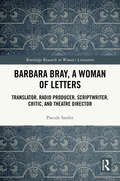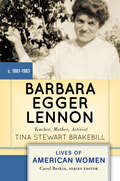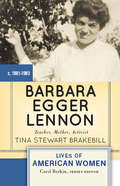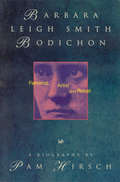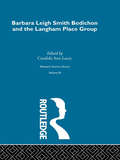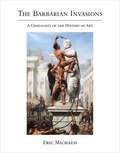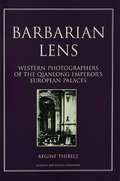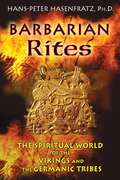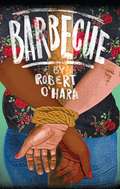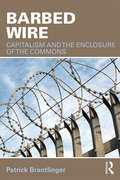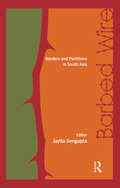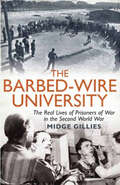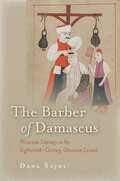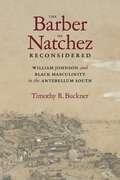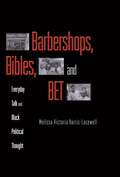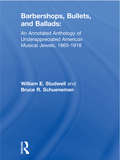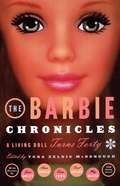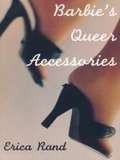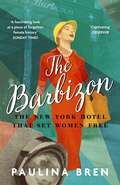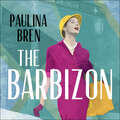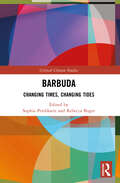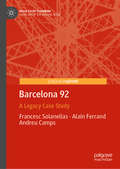- Table View
- List View
Barbara Bray, A Woman of Letters: Translator, Radio Producer, Scriptwriter, Critic, and Theatre Director (Routledge Research in Women's Literature)
by Pascale SardinBarbara Bray (1924-2010) was an English woman of letters who translated some hundred novels, plays, and essays from French to English and was Marguerite Duras’s preferred translator. She also collaborated with some of the most prestigious directors and playwrights of the 20th century – Harold Pinter, Samuel Beckett, Joseph Losey, and Franco Zeffirelli – helping them write screenplays and radioplays. This literary biography (re)evaluates in a textual, sociological, and historical perspective the social role of an English writer and translator in the history of ideas and contemporary art. Highlighting Bray’s influence in cultural transfers of ideas and literatures between France, Great Britain, and the United States, it renders visible the yet unrecognised work of a female mediator and creator. It nourishes the debate about women’s public voice and the representation of women in the media industries and contributes to enrich the ‘other’ history that is being currently written by feminist scholars around the world.
Barbara Egger Lennon: Teacher, Mother, Activist
by Tina Stewart BrakebillFacets of Barbara Egger Lennon’s life define her as an ordinary white Midwestern woman of her time: teacher, wife, mother. Her work as a union organizer and political activist, however, complicate that picture. The way in which she balanced these roles illustrates how many women of her time shaped their lives in the face of three significant forces: work, family, and politics. Enriched by years of detailed diary entries that Egger Lennon wrote, Barbara Egger Lennon: Teacher, Mother, Activist deepens our understanding of the ways in which work and political activism could exist alongside the traditional role of women in the early 20th century. About the Lives of American Women series: Selected and edited by renowned women’s historian Carol Berkin, these brief biographies are designed for use in undergraduate courses. Rather than a comprehensive approach, each biography focuses instead on a particular aspect of a women’s life that is emblematic of her time, or which made her a pivotal figure in the era. The emphasis is on a "good read,” featuring accessible writing and compelling narratives, without sacrificing sound scholarship and academic integrity. Primary sources at the end of each biography reveal the subject’s perspective in her own words. Study questions and an annotated bibliography support the student reader.
Barbara Egger Lennon: Teacher, Mother, Activist
by Tina Stewart BrakebillFacets of Barbara Egger Lennon’s life define her as an ordinary white Midwestern woman of her time: teacher, wife, mother. Her work as a union organizer and political activist, however, complicate that picture. The way in which she balanced these roles illustrates how many women of her time shaped their lives in the face of three significant forces: work, family, and politics. Enriched by years of detailed diary entries that Egger Lennon wrote, Barbara Egger Lennon: Teacher, Mother, Activist deepens our understanding of the ways in which work and political activism could exist alongside the traditional role of women in the early 20th century. About the Lives of American Women series: Selected and edited by renowned women’s historian Carol Berkin, these brief biographies are designed for use in undergraduate courses. Rather than a comprehensive approach, each biography focuses instead on a particular aspect of a women’s life that is emblematic of her time, or which made her a pivotal figure in the era. The emphasis is on a "good read,” featuring accessible writing and compelling narratives, without sacrificing sound scholarship and academic integrity. Primary sources at the end of each biography reveal the subject’s perspective in her own words. Study questions and an annotated bibliography support the student reader.
Barbara Egger Lennon: Teacher, Mother, Activist (Lives of American Women)
by Tina Stewart BrakebillFacets of Barbara Egger Lennon's life depict an ordinary white Midwestern woman of her time: teacher, wife, mother. Her work as a union organizer and political activist, however, complicate that picture. The way in which Egger Lennon balanced these roles illustrates how many women of her time shaped their lives in the face of three significant forces: work, family, and politics. Enriched by years of her detailed diary entries, Barbara Egger Lennon: Teacher, Mother, Activist deepens our understanding of the ways in which work and political activism existed alongside the traditional role of women in the early 20th century. About the Lives of American Women series:Selected and edited by renowned women's historian Carol Berkin, these brief biographies are designed for use in undergraduate courses. Rather than a comprehensive approach, each biography focuses instead on a particular aspect of a woman's life that is emblematic of her time, or which made her a pivotal figure in the era. The emphasis is on a good read," featuring accessible writing and compelling narratives, without sacrificing sound scholarship and academic integrity. Primary sources at the end of each biography reveal the subject's perspective in her own words. Study questions and an annotated bibliography support the student reader.
Barbara Leigh Smith Bodichon: Feminist, Artist and Rebel
by Pam HirschBarbara Leigh Smith Bodichon was the most unconventional and influential leader of the Victorian women's movement. Enormously talented, energetic and original, she was a feminist, law-reformer, painter, journalist, the close friend of George Eliot and a cousin of Florence Nightingale. As a painter, Barbara is now recognised as a vital figure among Pre-Raphaelite women artists. As a feminist she led four great campaigns: for married women's legal status, for the right to work, the right to vote and to education. Making brilliant use of unpublished journals and letters, Pam Hirsch has written a biography that is as lively and powerful as its subject, recreating the woman in all her moods, and placing her firmly in the context of women's struggle for equality.
Barbara Leigh Smith Bodichon and the Langham Place Group (Women's Source Library #Vol. 3)
by Candida Ann LaceyFirst published in 1987. Reprints material from the 1850's and 1860's, a period which marked a turning point in the history of British Feminism. At the centre of this was Barbara Leigh Smith Bodichon, whose pioneering schemes to improve the status of women made these years some of the richest in debate and reform
Barbara Wootton and the Legacy of a Pioneering Public Criminologist (Routledge Key Thinkers in Criminology)
by Philip BeanThis book offers an assessment of Barbara Wootton’s legacy as a pioneering public criminologist. Barbara Wootton (1897-1988) was a leading British social scientist, magistrate, academic and public servant. She was also a life peer (Baroness Wootton of Abinger) and the first woman to sit on the Woolsack in the House of Lords as Deputy Speaker. One of the Royal Commissions on which she served was on the Penal System, (1964) and two of the Departmental Committees were on the Business of the Criminal Courts (1958) and Criminal Statistics (1963). Of her written work perhaps the most famous is `Social Science and Social Pathology` (published in 1959) which was an attempt to discover what the social sciences had to say about criminality, its causes and its social effects. This book examines her career in historical context, and her contribution to thinking and scholarship on a range of topics. These topics range from the courts and the penal system and her report on the Community Service Order, to crime and criminal law and her analysis of the notions of mens rea, to her work on psychiatry and criminal justice. It explores her contribution as a utilitarian critic in Criminology, within the British empiricist tradition. Written in a clear and direct style, this book will appeal to students and scholars of criminology, sociology, criminal justice, law and all those interested in learning more about Barbara’s life and times.
The Barbarian Invasions: A Genealogy of the History of Art (October Books)
by Eric MichaudHow the history of art begins with the myth of the barbarian invasion—the romantic fragmentation of classical eternity. The history of art, argues Éric Michaud, begins with the romantic myth of the barbarian invasions. Viewed from the nineteenth century, the Germanic-led invasions of the Roman Empire in the fifth century became the gateway to modernity, seen not as a catastrophe but as a release from a period of stagnation, renewing Roman culture with fresh, northern blood—and with new art that was anti-Roman and anticlassical. Artifacts of art from then on would be considered as the natural product of “races” and “peoples” rather than the creation of individuals. The myth of the barbarian invasions achieved the fragmentation of classical eternity.This narrative, Michaud explains, inseparable from the formation of nation states and the rise of nationalism in Europe, was based on the dual premise of the homogeneity and continuity of peoples. Local and historical particularities became weapons aimed at classicism's universalism. The history of art linked its objects with racial groups—denouncing or praising certain qualities as “Latin” or “Germanic.” Thus the predominance of linear elements was thought to betray a southern origin, and the “painterly” a Germanic or northern source. Even today, Michaud points out, it is said that art best embodies the genius of peoples. In the globalized contemporary art market, the ethnic provenance of works—categorized, for example, as “African American,” “Latino,” or “Native American”—creates added value. The market displays the same competition among “races” that was present at the foundation of art history as a discipline.
Barbarian Lens: Western Photographers of the Qianlong Emperor's European Palaces
by Regine ThiriezPart of the prestigious academic book series Documenting the Image, this is a fascinating survey illustrated by extremely rare photographs of the burned architectural and landscape complex known as the Rape of the Summer Palace.In 1860, Western armies brought ruin to the treasured seat of the Qing emperors near Beijing. One hundred and fifty images
Barbarian Migrations and the Roman West, 376-568
by Guy HalsallThis is a major new survey of the barbarian migrations and their role in the fall of the Roman Empire and the creation of early medieval Europe, one of the key events in European history. Unlike previous studies it integrates historical and archaeological evidence and discusses Britain, Ireland, mainland Europe and North Africa, demonstrating that the Roman Empire and its neighbours were inextricably linked. A narrative account of the turbulent fifth and early sixth centuries is followed by a description of society and politics during the migration period and an analysis of the mechanisms of settlement and the changes of identity. Guy Halsall reveals that the creation and maintenance of kingdoms and empires was impossible without the active involvement of people in the communities of Europe and North Africa. He concludes that, contrary to most opinions, the fall of the Roman Empire produced the barbarian migrations, not vice versa.
Barbarian Rites: The Spiritual World of the Vikings and the Germanic Tribes
by Hans-Peter HasenfratzDiscover the untamed paganism of the Vikings and the Germanic tribes prior to the complete Christianization of Europe • Explores the different forms of magic practiced by these tribes, including runic magic, necromancy (death magic), soul-travel, and shape-shifting • Examines their rites of passage and initiation rituals and their most important gods, such as Odin, Loki, and Thor • Looks at barbarian magic in historical accounts, church and assembly records, and mythology as well as an eyewitness report from a 10th-century Muslim diplomat • Reveals the use and abuse of this tradition’s myths and magic by the Nazis Before the conversion of Europe to Christianity in the Middle Ages, Germanic tribes roamed the continent, plundering villages and waging battles to seek the favor of Odin, their god of war, ecstasy, and magic. Centuries later, predatory Viking raiders from Scandinavia carried on similar traditions. These wild “barbarians” had a system of social classes and familial clans with complex spiritual customs, from rites of passage for birth, death, and adulthood to black magic practices and shamanic ecstatic states, such as the infamous “berserker’s rage.” Chronicling the original pagan tradition of free and wild Europe--and the use and abuse of its myths and magic by the Nazis--Hans-Peter Hasenfratz offers a concise history of the Germanic tribes of Europe and their spiritual, magical, and occult beliefs. Looking at historical accounts, church and assembly records, mythology, and folktales from Germany, Russia, Scandinavia, and Iceland as well as an eyewitness report of Viking customs and rituals from a 10th-century Muslim diplomat, Hasenfratz explores the different forms of magic--including charms, runic magic, necromancy, love magic, soul-travel, and shamanic shape-shifting--practiced by the Teutonic tribes and examines their interactions with and eventual adaptation to Christianity. Providing in-depth information on their social class and clan structure, rites of passage, and their most important gods and goddesses, such as Odin, Loki, Thor, and Freyja, Hasenfratz reveals how it is only through understanding our magical barbarian roots that we can see the remnants of their language, culture, and dynamic spirit that have carried through to modern times.
Barbecue / Bootycandy (TCG Edition)
by Robert O'HaraSutter is on an outrageous odyssey through his childhood home, his church, dive bars, motel rooms, and even nursing homes. The journey uncovers characters who are at once fascinating, zany, controversial, and even a bit smutty, painting a portrait of life as a societal outlier. Based on the author's personal experience, Bootycandy is a kaleidoscope of sketches that interconnects to portray growing up gay and black. This subversive, uproarious satire crashes headlong into the murky terrain of pain and pleasure and . . . BOOTYCANDY!
Barbed Wire: Capitalism and the Enclosure of the Commons
by Patrick BrantlingerA call to transform the way we think about property, this book examines how capitalism has from its origins sought to enclose or privatize the commons, or land and other forms of property that had been viewed as communally owned, and argues that neoliberal economic policies and the corporate takeovers of urban spaces, prisons, schools, the mass media, farms, and natural resources have failed to serve the public interest. A study of corporate globalization and the continuation of empire after the era of political decolonization, it begins with the fencing of the West starting in the 1870s, and moves to examine recent phenomena such as urbanization, mass incarceration, financialization, and the treatment of people as commodities in the context of the longue durée of land enclosures, empire, and capitalism. Highlighting the threatened elimination of the public domain as a result of corporate efforts to privatize public utilities, prisons, schools, forests, seeds, and just about everything else that can yield a profit, Barbed Wire: Capitalism and the Enclosure of the Commons asks what it would mean if, instead of either private or public property, our most fundamental conception of property were communal. Would a redefinition of property from a community perspective lead us beyond the military-industrial complex?
Barbed Wire: Borders and Partitions in South Asia
by Jayita SenguptaThe book is an anthology of creative and critical responses to the many partitions of India within and across borders. By widening and reframing the question of partition in the subcontinent from one event in 1947 to a larger series of partitions, the book presents a deeper perspective both on the concept of partition in understanding South Asia, and understanding the implications from survivors, victims and others. The imagery of the barbed wire in the title is used precisely to confront the jaggedness of experiencing and surviving partition that still haunts the national, literary, religious and political matrices of India. The volume is a compilation of short stories, poems, articles, news reports and memoirs, with each contributor bringing forth their perception of partition and its effects on their life and identity. The many narratives amplify the human cost of partitions, examining the complexities of a bruised nation at the social, psychological and religious levels of consciousness. The book will appeal to anyone interested in literary studies, history, politics, sociology, cultural studies, and comparative literature.
The Barbed-Wire University: The Real Lives of Prisoners of War in the Second World War
by Midge Gillies“A moving and eye-opening account of the lives of second world war PoWs by the daughter of a man who was captured . . . a riveting collection of stories.” —The GuardianFeature films like The Bridge on the River Kwai and The Great Escape have created the stereotype of the Second World War prisoner of war. But, as Midge Gillies shows in this groundbreaking work of social history, the true experiences of nearly half a million Allied servicemen held captive during the Second World War were nothing like the Hollywood myth—and infinitely more extraordinary.The real lives of POWs saw them respond to the tedium of a German stalag or the brutality of a Japanese camp with the most amazing ingenuity and creativity. They staged glittering shows, concerts and elaborate sporting fixtures, made exquisite ornaments—even, amid the terrible privations of the Thailand-Burma railway, improvised daring surgical techniques to save their fellow men’s lives. Whatever skills or hobbies they took with them to captivity they managed to continue and adapt—to the extent of laying out a 9-hole golf course between the huts of one German camp. They took up crafts and pastimes using materials they found around them: even the string from a Red Cross food parcel was used to make cricket balls, football nets and wigs for theatrical performances. Men studied, attended lectures, learned languages, sat for qualifications and exams, on such a scale that one camp was nicknamed “The Barbed-Wire University.”Drawing on letters home, diaries and interviews with redoubtable survivors now into their nineties, Midge Gillies recreates the daily lives of a truly remarkable group of men. “Astonishing tales of improvisation, ingenuity and courage.” —The Spectator
The Barber of Damascus: Nouveau Literacy in the Eighteenth-Century Ottoman Levant
by Dana SajdiThis book is about a barber, Shihab al-Din Ahmad Ibn Budayr, who shaved and coiffed, and probably circumcised and healed, in Damascus in the 18th century. The barber may have been a "nobody," but he wrote a history book, a record of the events that took place in his city during his lifetime. Dana Sajdi investigates the significance of this book, and in examining the life and work of Ibn Budayr, uncovers the emergence of a larger trend of history writing by unusual authors—people outside the learned establishment—and a new phenomenon: nouveau literacy. The Barber of Damascus offers the first full-length microhistory of an individual commoner in Ottoman and Islamic history. Contributing to Ottoman popular history, Arabic historiography, and the little-studied cultural history of the 18th century Levant, the volume also examines the reception of the barber's book a century later to explore connections between the 18th and the late 19th centuries and illuminates new paths leading to the Nahda, the Arab Renaissance.
The Barber of Natchez Reconsidered: William Johnson and Black Masculinity in the Antebellum South
by Timothy R. BucknerWinner of the Jules and Frances Landry AwardHistorians have long considered the diary of William Johnson, a wealthy free Black barber in Natchez, Mississippi, to be among the most significant sources on free African Americans living in the antebellum South. Timothy R. Buckner’s The Barber of Natchez Reconsidered reexamines Johnson’s life using recent scholarship on Black masculinity as an essential lens, demonstrating a complexity to Johnson previously overlooked in academic studies.While Johnson’s profession as a barber helped him gain acceptance and respectability, it also required his subservience to the needs of his all-white clientele. Buckner’s research counters earlier assumptions that suggested Johnson held himself apart from Natchez’s Black population, revealing instead a man balanced between deep connections to the broader African American community and the necessity to cater to white patrons for economic and social survival.Buckner also highlights Johnson’s participation in the southern performance of manliness to a degree rarely seen in recent studies of Black masculinity. Like many other free Black men, Johnson asserted his manhood in ways beyond simply rebelling against slavery; he also competed with other men, white and Black, free and enslaved, in various masculine pursuits, including gambling, hunting, and fishing. Buckner’s long-overdue reevaluation of the contents of Johnson’s diary serves as a corrective to earlier works and a fascinating new account of a free African American business owner residing in the prewar South.
Barbershops, Bibles, and BET: Everyday Talk and Black Political Thought
by Melissa Harris-PerryWhat is the best way to understand black political ideology? Just listen to the everyday talk that emerges in public spaces, suggests Melissa Harris-Lacewell. And listen this author has--to black college students talking about the Million Man March and welfare, to Southern, black Baptists discussing homosexuality in the church, to black men in a barbershop early on a Saturday morning, to the voices of hip-hop music and Black Entertainment Television. Using statistical, experimental, and ethnographic methods Barbershops, Bibles, and B.E.T offers a new perspective on the way public opinion and ideologies are formed at the grassroots level. The book makes an important contribution to our understanding of black politics by shifting the focus from the influence of national elites in opinion formation to the influence of local elites and people in daily interaction with each other. Arguing that African Americans use community dialogue to jointly develop understandings of their collective political interests, Harris-Lacewell identifies four political ideologies that constitute the framework of contemporary black political thought: Black Nationalism, Black Feminism, Black Conservatism and Liberal Integrationism. These ideologies, the book posits, help African Americans to understand persistent social and economic inequality, to identify the significance of race in that inequality, and to devise strategies for overcoming it.
Barbershops, Bullets, and Ballads: An Annotated Anthology of Underappreciated American Musical Jewels, 1865-1918
by William E Studwell Bruce R SchuenemanThrough Barbershops, Bullets, and Ballads: An Annotated Anthology of Underappreciated American Musical Jewels, 1865--1918, you will discover older musical gems written during a half-century period of geographical, economic, political, and cultural expansion in the United States. Due to the fact that our collective American consciousness is rapidly developing cultural amnesia about or indifference to many of these older songs, the authors felt that a scholarly anthology needed to be produced before another century and millennium overwhelmed us. With Barbershops, Bullets, and Ballads, you will discover academic composers such as Arthur Foote, George Chadwick, and Amy Beach and find annotations outlining the history of the songs as well as the actual words and music.Barbershops, Bullets, and Ballads reveals to you such underappreciated songs as: “Above in Her Chamber,” with music by Julius Eichberg and lyrics by poet Celia Thaxter “In the Evening by the Moonlight,” with music and lyrics by James A. Bland “My Wild Irish Rose,” with music and lyrics by Chauncey Olcott “Cheyenne,” by lyricist Harry H. Williams and composer Egbert Van Alstyne “Come, Josephine in My Flying Machine,” with music by Fred Fisher and lyrics by Alfred BryanIn Barbershops, Bullets, and Ballads, you will find sections containing historical notes of featured songs in chronological order. Through this remarkable collection, you will discover an anthology of popular music of the bygone “golden age” of song and take a pleasurable voyage back to a time that is long gone.
The Barbie Chronicles
by Yona Zeldis McdonoughA THOROUGHLY GROWN-UP LOOK AT A TWENTIETH-CENTURY MUSE OF OUTSTANDING PROPORTIONS To some she's a collectible, to others she's trash. In The Barbie Chronicles, twenty-three writers join together to scrutinize Barbie's forty years of hateful, lovely disastrous, glorious influence on us all. No other tiny shoulders have ever, had to carry the weight of such affection and derision and no other book has ever paid this notorious little place of plastic her due. Whether you adore her or abhor her, The Barbie Chronicles will have you looking at her in ways you never imagined.
Barbie’s Queer Accessories
by Erica RandShe's skinny, white, and blond. She's Barbie--an icon of femininity to generations of American girls. She's also multiethnic and straight--or so says Mattel, Barbie's manufacturer. But, as Barbie's Queer Accessories demonstrates, many girls do things with Barbie never seen in any commercial. Erica Rand looks at the corporate marketing strategies used to create Barbie's versatile (She's a rapper! She's an astronaut! She's a bride!) but nonetheless premolded and still predominantly white image. Rand weighs the values Mattel seeks to embody in Barbie--evident, for example, in her improbably thin waist and her heterosexual partner--against the naked, dyked out, transgendered, and trashed versions favored by many juvenile owners and adult collectors of the doll.Rand begins by focusing on the production and marketing of Barbie, starting in 1959, including Mattel's numerous tie-ins and spin-offs. These variations, which include the much-promoted multiethnic Barbies and the controversial Earring Magic Ken, helped make the doll one of the most profitable toys on the market. In lively chapters based on extensive interviews, the author discusses adult testimony from both Barbie "survivors" and enthusiasts and explores how memories of the doll fit into women's lives. Finally, Rand looks at cultural reappropriations of Barbie by artists, collectors, and especially lesbians and gay men, and considers resistance to Barbie as a form of social and political activism.Illustrated with photographs of various interpretations and alterations of Barbie, this book encompasses both Barbie glorification and abjection as it testifies to the irrefutably compelling qualities of this bestselling toy. Anyone who has played with Barbie--or, more importantly, thought or worried about playing with Barbie--will find this book fascinating.
The Barbizon: The New York Hotel That Set Women Free
by Paulina BrenAS HEARD ON RADIO 4 WOMAN'S HOURBEST NON-FICTION OF 2021, EVENING STANDARD'Captivating ... a brilliant many-layered social history of women's ambition and a rapidly changing New York' Observer 'A fascinating look at a piece of forgotten female history' Sunday Times 'A treat, elegantly spinning a forgotten story of female liberation, ambition and self-invention' Guardian 'A deeply researched history, leavened with gossip ... offers a full sweep of the changing status of American women in the twentieth century' TLSWELCOME TO THE BARBIZON, NEW YORK'S PREMIER WOMEN-ONLY HOTEL Built in 1927 as a home for the 'Modern Woman' seeking a career in the arts, the Barbizon became the place to stay for ambitious, independent women, who were lured by the promise of fame and good fortune. Sylvia Plath fictionalized her time there in The Bell Jar, and over the years, its 688 tiny floral 'highly feminine boudoirs' also housed Joan Crawford, Grace Kelly (notorious for sneaking in men), Joan Didion, Candice Bergen, Charlie's Angel Jaclyn Smith, Ali MacGraw, Cybil Shepherd, Elaine Stritch, Liza Minnelli, Eudora Welty, The Cosby Show's Phylicia Rashad, Grey Gardens's Edith Bouvier Beale, and writers Mona Simpson and Ann Beattie, among many others. Mademoiselle boarded its summer interns there - perfectly turned-out young women, who would never be spotted hatless - as did Katherine Gibbs Secretarial School its students - in their white-gloves and kitten heels - and the Ford Modelling Agency its young models. THE BARBIZON is a colourful, glamorous portrait of the lives of the young women, who -- from the Jazz Age New Women of the 1920s to the Liberated Women of the 1960s -- came to New York looking for something more.'The story of the Barbizon is in many ways the story of American women in the twentieth century' Economist 'Illuminating . . . this vivid, well researched account is testament to its vibrant history and the women who made it such a powerhouse' Daily Express
The Barbizon: The New York Hotel That Set Women Free
by Paulina BrenA glamorous social history of the women-only New York hotel that changed the world.WELCOME TO THE BARBIZON, NEW YORK'S PREMIER WOMEN-ONLY HOTEL Built in 1927, New York's Barbizon Hotel was first intended as a home for the 'Modern Woman' seeking a career in the arts. It became the place to stay for ambitious, independent women, who were lured by the promise of fame and good fortune. Sylvia Plath fictionalized her time there in The Bell Jar, and over the years, its 688 tiny pink 'highly feminine boudoirs' also housed Joan Crawford, Grace Kelly (notorious for sneaking in men), Joan Didion, Candice Bergen, Charlie's Angel Jaclyn Smith, Ali McGraw, Cybil Shepherd, Elaine Stritch, Liza Minnelli, Eudora Welty, The Cosby Show's Phylicia Rashad, and writers Mona Simpson and Ann Beattie, among many others. Mademoiselle boarded its summer interns there - perfectly turned-out young women, who would never be spotted hatless - as did Katherine Gibbs Secretarial School its students - in their white-gloves and kitten heels - and the Ford Modelling Agency its young models. Not everyone who passed through the Barbizon's doors was destined for greatness - for some it was a story of dashed hopes and expectations - but from the Jazz Age New Women of the 1920s, to the Liberated Women of the 1960s, until 1981 when the first men checked in, The Barbizon was a place where women could stand up and be counted. THE BARBIZON is a colourful, glamorous portrait of the lives of these young women, who came to New York looking for something more. It's a story of pushing the boundaries, of women's emancipation and of the generations of brilliant women who passed through its halls.(P) 2021 Hodder & Stoughton Ltd
Barbuda: Changing Times, Changing Tides (Critical Climate Studies)
by Sophia Perdikaris and Rebecca BogerThis volume explores a range of themes including impacts of climate change, resilience, sustainability, indigeneity, cultural genocide, disaster capitalism, preservation of biodiversity, and environmental degradation. Focusing on the island of Barbuda in the West Indies, it shares critical insights into how climate change is reshaping our world. The book examines how climate has changed in the Caribbean over different spatial and temporal scales and how varying natural and anthropogenic factors have shaped Barbuda’s climatic and cultural history. It highlights projections of 21st-century climate change for the Caribbean region and its likely impacts on Barbuda’s coastal ecosystems, potable groundwater resources, and heritage. With essays by researchers from the United States, Canada, Caribbean, and Europe, this volume straddles a range of disciplines such as archaeology, anthropology, paleoclimatology, environmental sciences, science education, and Traditional Ecological Knowledge (TEK). Drawing on interdisciplinary and transdisciplinary approaches that explore the intersection of natural and social systems over the longue durée, the volume will be of interest to scholars, researchers, and students of ethnography, social anthropology, climate action, development studies, public policy, and climate change.
Barcelona 92: A Legacy Case Study (Mega Event Planning)
by Francesc Solanellas Alain Ferrand Andreu CampsBarcelona 92: A Legacy Case Study examines the effects of the organisation of Barcelona’s Olympic Games in 1992. Divided into five compelling chapters, the authors discuss issues concerning the definition of legacy, whilst also presenting new models of legacy management and measurement methods, and providing an in-depth examination of sporting, economic and social dimensions. This book offers the most significant studies and research on the 92 Olympics to date, presenting cutting-edge proposals for comparing different Olympic hosting cities into the future.
